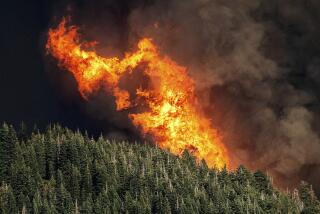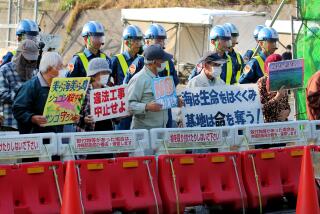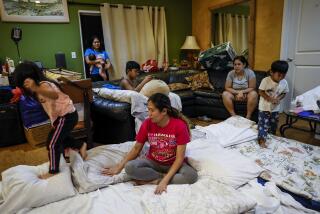Islanders Yearn to Return to Bikini Atoll
EJIT, Marshall Islands — A harmony of soulful voices and hopeful words drifted up from the whitewashed church and out over the island.
“Standing ... Standing ... I’m standing on the promises of God.”
Women with flowers in their hair, men in neat Sunday shirts joined in the hymn to a promised future. Children crowding the concrete floor listened. Beneath a pew, in the morning heat, a dog lay panting.
The pastor stepped up to his pulpit and commended the 100-strong congregation for its undying faith. We are like the children of Israel, Lannij Johnson told the people of Bikini.
But outside, in the church’s shadows, another Bikinian sounded a less faithful note.
“The children of Israel wandered in the desert for only 40 years,” Alson Kelen, 36, reminded a visitor. Already the people of Bikini -- “the children of America,” they call themselves -- have wandered for 58, and their journey, more than ever, looks like an exodus without end.
*
On March 17 in Washington, 7,000 miles east of here, the U.S. House of Representatives unanimously adopted a resolution hailing the half-century “strategic partnership” with these people of the mid-Pacific, a partnership in which they lost their home islands to U.S. nuclear bomb tests, and from which they fear that Washington may soon walk away.
The resolution noted “the cost of preserving peace.” But the U.S. government, after disbursing $191 million since the 1970s, is offering nothing new to the Bikinians, no further compensation to revive hopes that Bikini atoll might be purged of lingering radioactivity, and that Bikinians might return to the abandoned islands.
Jack Niedenthal, Bikinian by marriage and spokesman for the islanders, believes that Washington, while spending billions elsewhere around the world, has not repaid its debt here.
“When you look at what they’re doing in Iraq, in Afghanistan ....” He paused. “We’re their friends, and here we sit a half-century later. We’re sitting here.”
The House resolution commemorated the day, March 1, 1954, when the United States set off a hydrogen bomb test, dubbed Bravo, at the western end of Bikini atoll -- 23 coral islands ringing a 25-mile-wide lagoon in the northern Marshall Islands. It was the biggest U.S. nuclear blast in history.
The islanders had been evacuated eight years earlier, at the start of the testing program. Their chief, known by the single name Juda, said then that they were agreeing to it because he’d been told that the bombs would produce “kindness and benefit to all mankind,” and that his people could return after the tests.
Because of shifting winds and because U.S. bomb-makers had vastly underestimated the power of the monstrous Bravo explosion, it unexpectedly dumped heavy fallout on the main island of Bikini, and even farther away on inhabited atolls, Rongelap and Utrik, whose people have been afflicted by severe medical problems ever since.
Between 1946 and 1958, the United States detonated 67 nuclear tests in the Marshalls, then a U.S. protectorate under the United Nations. The megatonnage was equal to exploding 1.6 Hiroshima atomic bombs a day for 12 years. Twenty-three tests took place at Bikini; four of its islets were vaporized.
By 1948, the wandering Bikinians had been settled on rockbound Kili, a tiny, undesirable island in the southern Marshalls, where they grew dependent on U.S. handouts of canned food. In the 1970s, reassured by U.S. scientists, some returned to Bikini. But they were re-evacuated in 1978, having absorbed dangerous amounts of radioactive cesium. The Americans had mistakenly judged Bikini to be safe.
Many of the evacuees landed on uninhabited Ejit, a palmy, half-mile-long island in Majuro atoll, capital of the Marshalls, which today are an independent nation closely tied to the U.S.
By island standards, life here is comfortable -- telephone, electricity, even $25-a-month cable television for those who can afford it. But the water supply, via catchment rainwater, often runs low, and the simple cinderblock housing is cramped, in a settlement that one can walk across in three minutes.
Because of a high birthrate and marriages to people from other islands, the count of “official” Bikinians has exploded, to more than 3,000, since Juda led 167 off the island in 1946. About 1,000 live on Kili, 400 on Ejit, and others on the main island of Majuro or in the United States, where 300 students are in school.
In exile, a culture of atomic victimhood has evolved.
Ejit’s schoolchildren, in their rudimentary classrooms, sport orange T-shirts emblazoned with an atomic bomb’s mushroom cloud, a Bible and the trusting motto ascribed to Juda: “Men Otemjej Rej Ilo Bein Anij,” Marshallese for “Everything is in the hands of God.”
Those hands will lead them back to Bikini, islanders believe. And “if it is cleaned completely, they would go back 100%,” said the late chief’s son, Tomaki Juda, 60, the Bikini senator in the Marshalls’ legislature.
Younger generations hear almost mythical tales of a pristine Bikini, where fish abounded in the lagoon, and outer islands covered with coconut, pandanus and breadfruit trees fed the people.
“Yes, I’d like to live there,” Rosalina Jakeo, 25, told a visitor to Ejit, where she was found idly strumming a ukulele outside her house. “Compared to this” -- she gestured around crowded Ejit -- “it’s a nice place.”
After church, Jake Risino, 19, said she’d often heard from her parents about Bikini, 500 miles away, and she’d like to go there. “It’s my home.”
But what about the 1-year-old daughter on her hip? No, she said, “I want her to get educated and go to America.”
Younger Bikinians, like Risino, are quick to discard the dream and recall the reality when asked about the future.
“Bikini is a vague concept to them, not something they think of as home,” teacher Colleen Cullen, 22, of Bellport, N.Y., said of her pupils on Ejit. She’s one of half a dozen Dartmouth College graduates teaching Bikinians under a three-year-old program.
“It would be kind of scary to live there,” said a Bikinian schoolteacher, Berman Caleb, 25. “I don’t know if it’s safe.”
More and more, the United States is the promised land.
In the 1980s, the Bikinians explored a mass move to a piece of land on the Hawaiian island of Maui. But native Hawaiians objected to the “invasion,” and the proposal was dropped.
A few Bikinians have congregated -- for work, through family connections -- in such places as Costa Mesa and Springdale, Ark.
But people here say the shy, poorly educated islanders aren’t likely to emigrate individually in great numbers, even though Marshallese have open access to the United States and even minimum-wage jobs there might multiply their incomes.
Over the years, Washington financed a patchwork of compensation funds for Bikinians and other Marshall Islanders affected by nuclear testing, including years of medical monitoring and care for Rongelap and Utrik islanders who developed high rates of cancer and other medical problems.
One remaining trust pays $220 a quarter to each Bikinian -- $4,400 a year for a family of five.
That trust was drawn from $75 million in reparations payments made under a “compact of free association” that the Marshall Islands negotiated with Washington in gaining independence in 1986. This was to be a “full and final” payment on all nuclear claims.
Other U.S. money enabled the Bikinians in the mid-1990s to do preparatory work for a “big scrape” -- removal of 15 inches of cesium-laced topsoil from 100 acres of Bikini island, the atoll’s main living area. But that work halted when the Bikinians opted for a strict U.S. standard for decontamination, a more expensive approach.
Then, in 2001, a Majuro-based Nuclear Claims Tribunal, created under the compact, held that the Bikinians should be awarded an additional $563 million in damages, including $251 million for restoring Bikini.
Because that tribunal had less than $10 million available, the Marshall Islands government petitioned Congress, asking that the U.S. government make those payments. In 2002, Congress asked the Bush administration to review the request.
The administration is expected to finally report on the issue this summer, said Brian Kennedy, spokesman for the House Resources Committee, which has jurisdiction. He said the committee would then decide “how and if” to take action.
A State Department official, speaking on condition of anonymity, said the petition had been put aside for two years as government experts dealt with a higher priority: renegotiating general financial aid for the Marshalls after the 15-year accord expired in 2001.
Niedenthal sounds pessimistic. “It looks like the U.S. is walking away from things,” said the 46-year-old Harrisburg, Pa., native and onetime Peace Corps volunteer in the Marshalls.
He said he also was worried by another new development: The U.S. Energy Department has cut funding for its field missions to check radiation and the environment in Bikini.
“They shut it down without telling us,” said Hinton Johnson, an Ejit member of Bikini’s governing council.
Energy Department spokesman Jeff Sherwood confirmed in Washington that environmental sampling at Bikini was suspended, saving $1.5 million this year, while a backlog of earlier work was analyzed. But he says it will be resumed at some point.
A leading champion of the Bikinians is the president of the Marshalls, Kessai Note, 53, a Bikinian himself, first elected in 2000 to lead this nation of scattered atolls and 57,000 people.
The Americans “could have done more to help the Bikinians,” Note said in an interview at his Majuro office. At a Bikinian funeral the night before, he said, “I spoke of injustice. These are people who have been away from their homeland for 50 years. That’s a lifetime. And it doesn’t look like they’ll return anytime in the near future.”
Kelen Joash, 74, a Sunday regular at Pastor Johnson’s church, has more faith.
“America can do it,” said Joash, who was 16 when taken from Bikini. “Maybe it can’t be Bikini, but maybe the U.S. can find someplace else for us -- big enough for a growing population.”
After all, he added, reaching back to hopeful words first heard when he was young, “we’re the children of America.”
More to Read
Sign up for Essential California
The most important California stories and recommendations in your inbox every morning.
You may occasionally receive promotional content from the Los Angeles Times.









